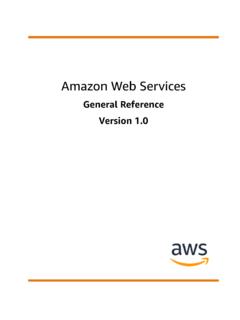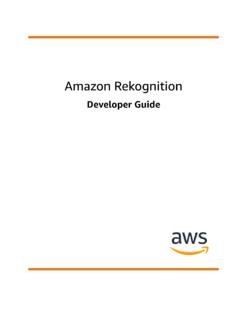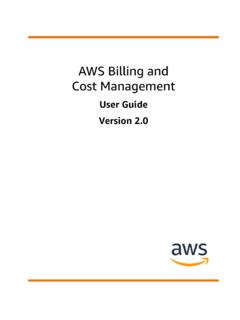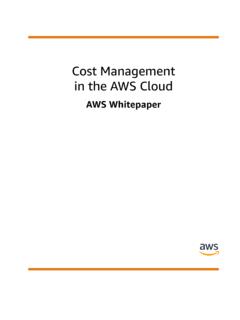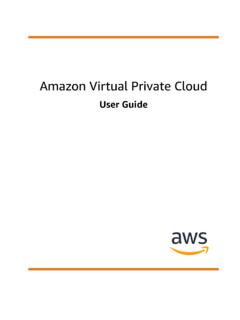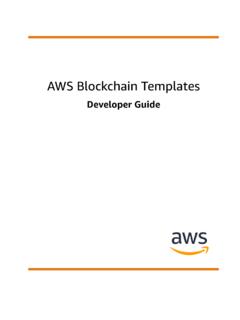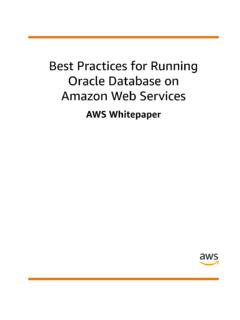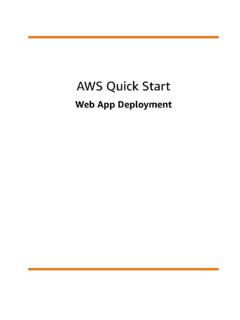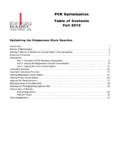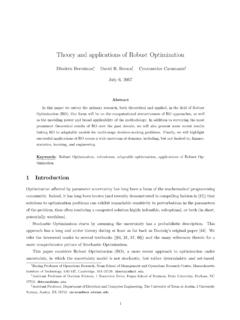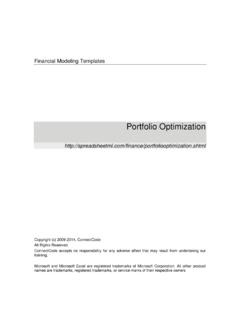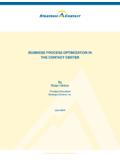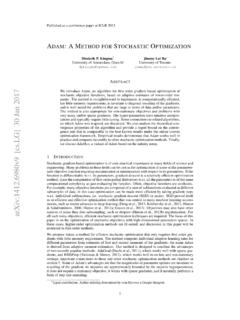Transcription of Laying the Foundation: Setting Up Your …
1 Laying the Foundation: Setting Up Your Environmentfor Cost OptimizationAWS WhitepaperLaying the Foundation: Setting Up YourEnvironment for Cost optimization AWS WhitepaperLaying the Foundation: Setting Up Your Environment for CostOptimization: AWS WhitepaperCopyright 2019 Amazon Web Services, Inc. and/or its affiliates. All rights 's trademarks and trade dress may not be used in connection with any product or service that is not Amazon's, in any mannerthat is likely to cause confusion among customers, or in any manner that disparages or discredits Amazon.
2 All other trademarks notowned by Amazon are the property of their respective owners, who may or may not be affiliated with, connected to, or sponsored the Foundation: Setting Up YourEnvironment for Cost optimization AWS WhitepaperTable of ContentsLaying the Foundation: Setting Up Your Environment for Cost optimization .. 1 Abstract .. 1 Introduction .. 1 Cost optimization 2 Cost Allocation Supports Ownership and Accountability .. 3 Use Tagging to Organize Your Environment and Drive Accountability.
3 4 Define Mandatory Cost Tagging .. 4 Enforce Quality of Tagging .. 4 Tagging Tools .. 4 AWS Account Structure Considerations .. 6 Measurement and Management .. 7 Enable Teams to Architect for Cost .. 8 Create a Cloud Center of Excellence .. 10 AWS Tools for Reporting and Cost optimization .. 12 Resources .. 13 Document 14 Document History .. 14 AWS Glossary .. 15iiiLaying the Foundation: Setting Up YourEnvironment for Cost optimization AWS WhitepaperAbstractLaying the Foundation: SettingUp Your Environment for CostOptimizationPublication date: March 2018 (Document Details (p.))
4 14))AbstractThis is the first in a series of whitepapers designed to support your cloud journey. This paper seeksto empower you to maximize value from your investments, improve forecasting accuracy and costpredictability, create a culture of ownership and cost transparency, and continuously measure youroptimization paper discusses the pillars of cost optimization and the key mechanisms for achieving cloud offers tremendous opportunity for increased agility, faster innovation, and lower total cost ofownership.
5 The organizations that are the most successful in moving from on-premises environmentsto the cloud are those that establish a well-defined strategy for approaching this new IT operatingmodel early in their journey. Moving from a model of large upfront investment in data centers to theconsumption-based model of AWS requires changes to tools, processes, and mindsets to ensure thatcosts are effectively most important practice for effectively optimizing costs with AWS is to start early. Although manycost optimization practices are relatively easy to implement in small environments, you need newoperational best practices, automation, and organizational incentives to be successful at scale acrosslarge environments and enterprises.
6 Establishing these best practices early in your journey can help youestablish the right processes and behaviors to ensure success when you hit the Foundation: Setting Up YourEnvironment for Cost optimization AWS WhitepaperCost optimization PillarsRegardless of your workload or architecture, there are five cost optimization pillars that apply acrossnearly all environments. The pillars of cost optimization are: Right size Ensure that what you provision matches what you need. For example, for compute, youprovision for CPU, memory, storage, and network throughput.
7 Increase elasticity Traditional IT costs and hardware requirements are tailored for peak usage andare rarely turned off. In the cloud, you can optimize cost to meet dynamic needs and turn resources offwhen they are not needed. For example, you can usually turn off non-production instances for 70% ormore of any given week. Leverage the right pricing model AWS provides a range of pricing models (On-Demand and SpotInstances for variable workloads and Reserved Instances for predictable workloads). Choose the rightpricing model to optimize costs based on the nature of your workload.
8 Optimize storage AWS provides multiple storage tiers at prices designed to meet performance. Byidentifying the most appropriate destination for specific types of data, you can reduce Amazon ElasticBlock Store (Amazon EBS) and Amazon Simple Storage Service (Amazon S3) while maintaining therequired performance and availability. For example, where performance requirements are lower, usingAmazon EBS Throughput Optimized HDD (st1) storage typically costs half as much as the defaultGeneral Purpose SSD (gp2) storage option.
9 Measure, monitor, and improve To ensure that you extract the full economic potential of the AWSC loud at any scale, you want to: Define and enforce cost allocation tagging. Define metrics, set targets, and review at a reasonable cadence. Enable teams to architect for cost via training, visualization of progress goals, and a balance ofincentives. Assign optimization responsibility to an individual or to a the Foundation: Setting Up YourEnvironment for Cost optimization AWS WhitepaperCost Allocation Supports Ownershipand AccountabilityIn a traditional data center, teams have to either architect within the limitations of existing investmentsor request the deployment of additional, capital-intensive resources that are often spread across manyprojects and cloud is fundamentally different.
10 AWS provides much greater capacity, flexibility, and ease ofdeployment. However, with these benefits comes the requirement to manage costs. With AWS resourcetagging, it is possible for you to have direct accountability and visibility into IT costs by team andapplication. The cloud also has the potential to decentralize IT procurement, which can lead to a lackof accountability if you do not set up the right visibility and control mechanisms within the the Foundation: Setting Up YourEnvironment for Cost optimization AWS WhitepaperDefine Mandatory Cost TaggingUse Tagging to OrganizeYour Environment and DriveAccountabilityTagging your AWS resources lets you assign custom metadata to instances, images, and other example, you can categorize resources by owner, purpose, or environment, which helps you organizethem and assign cost Mandatory Cost TaggingAn effective tagging strategy will give you improved visibility and monitoring.
